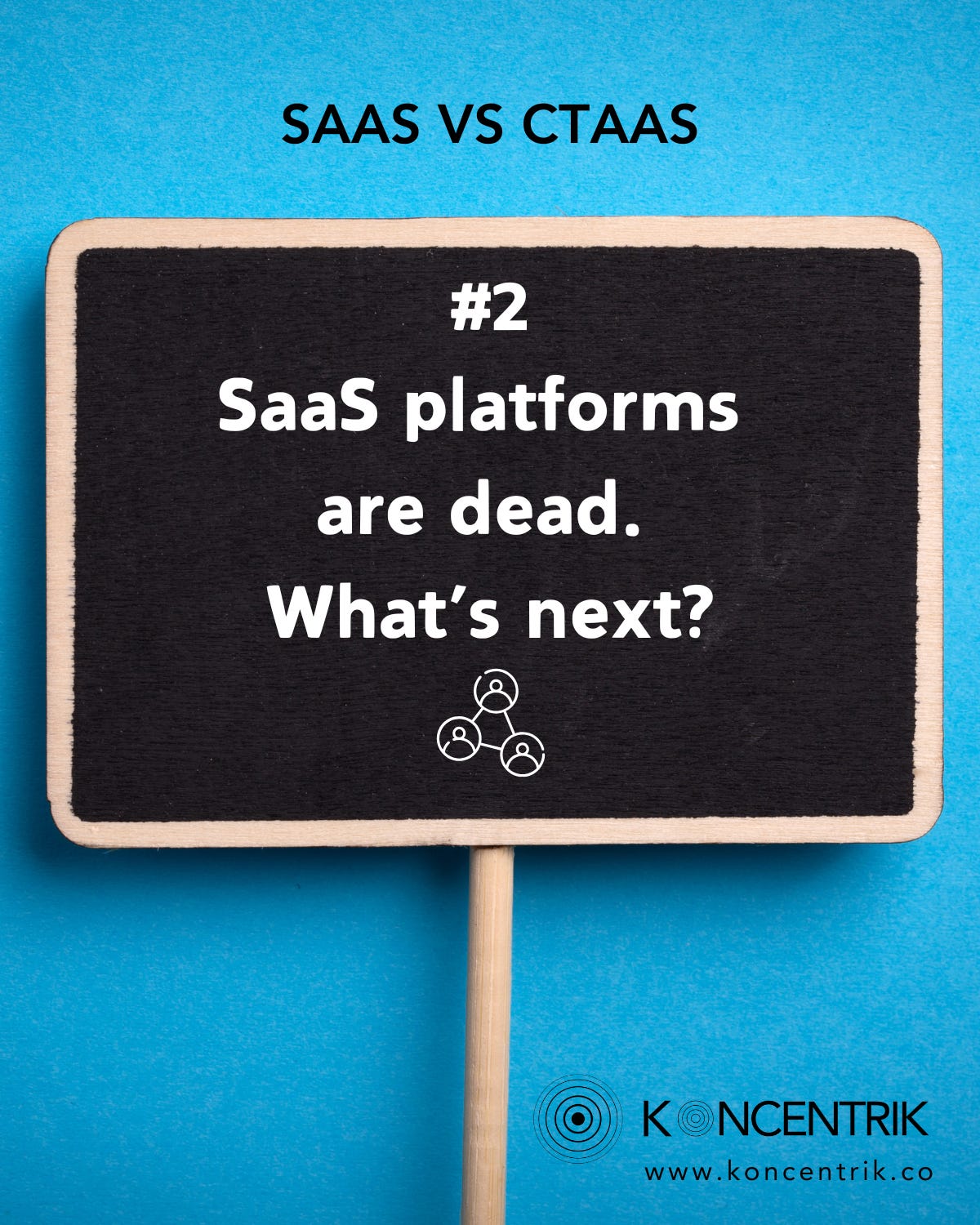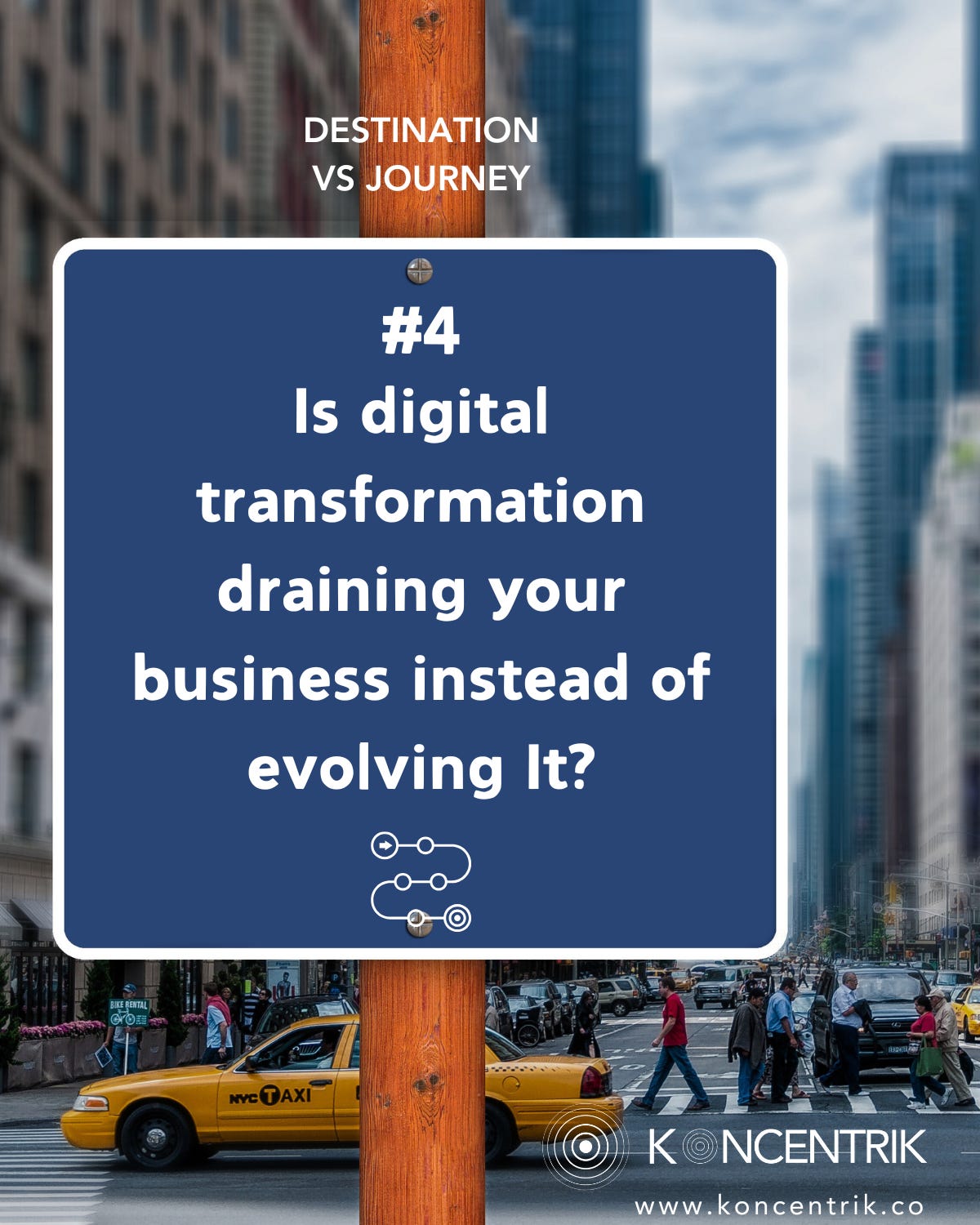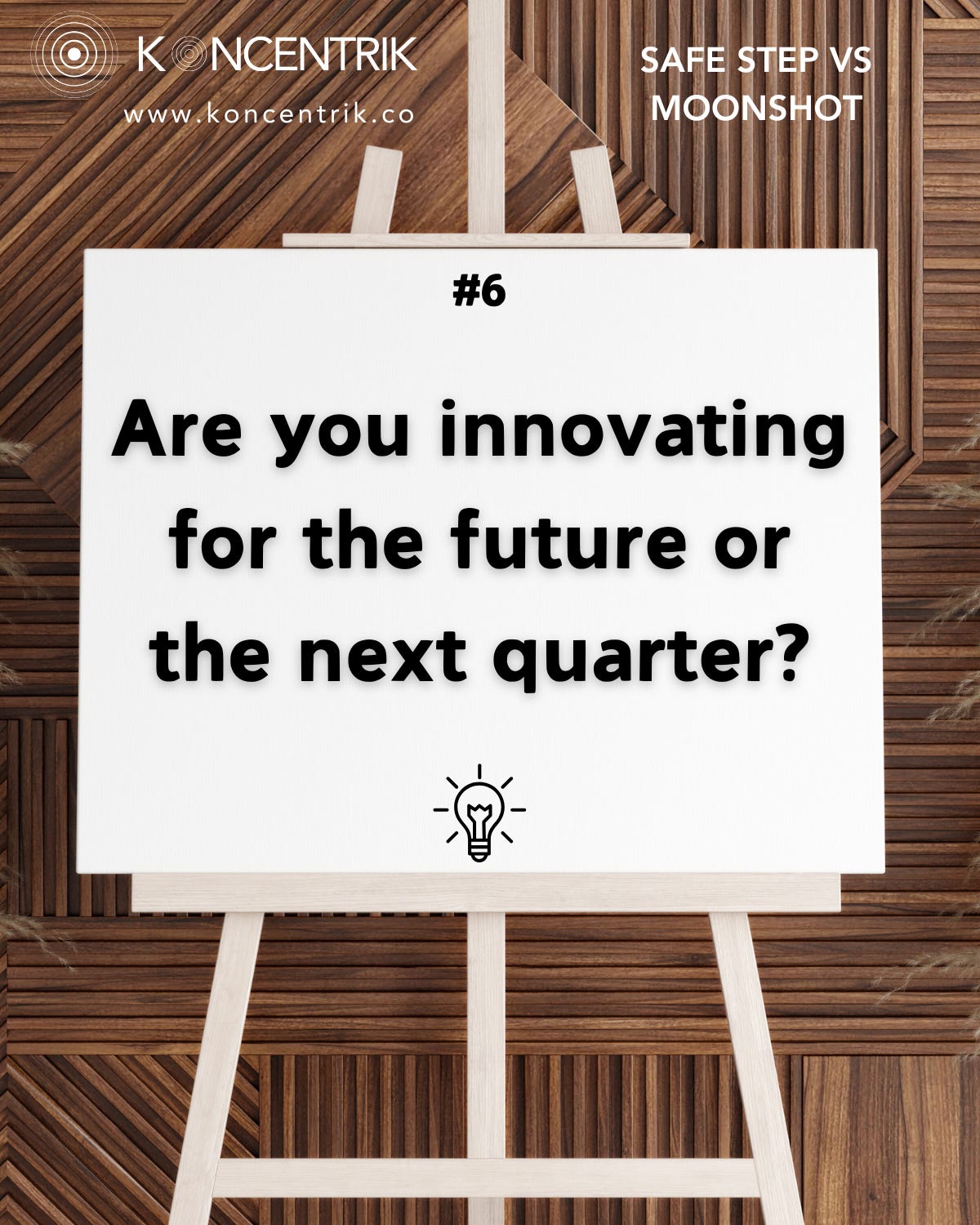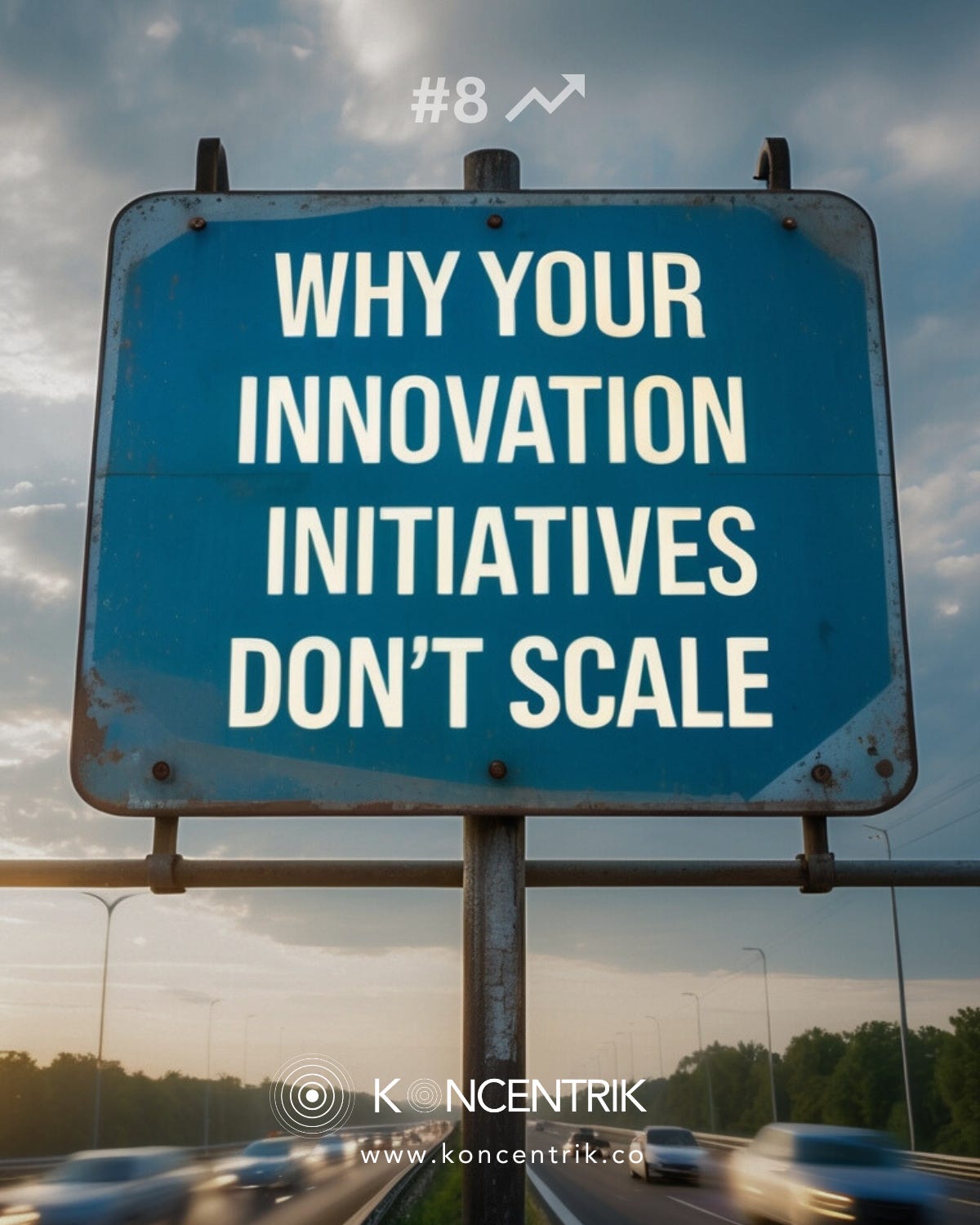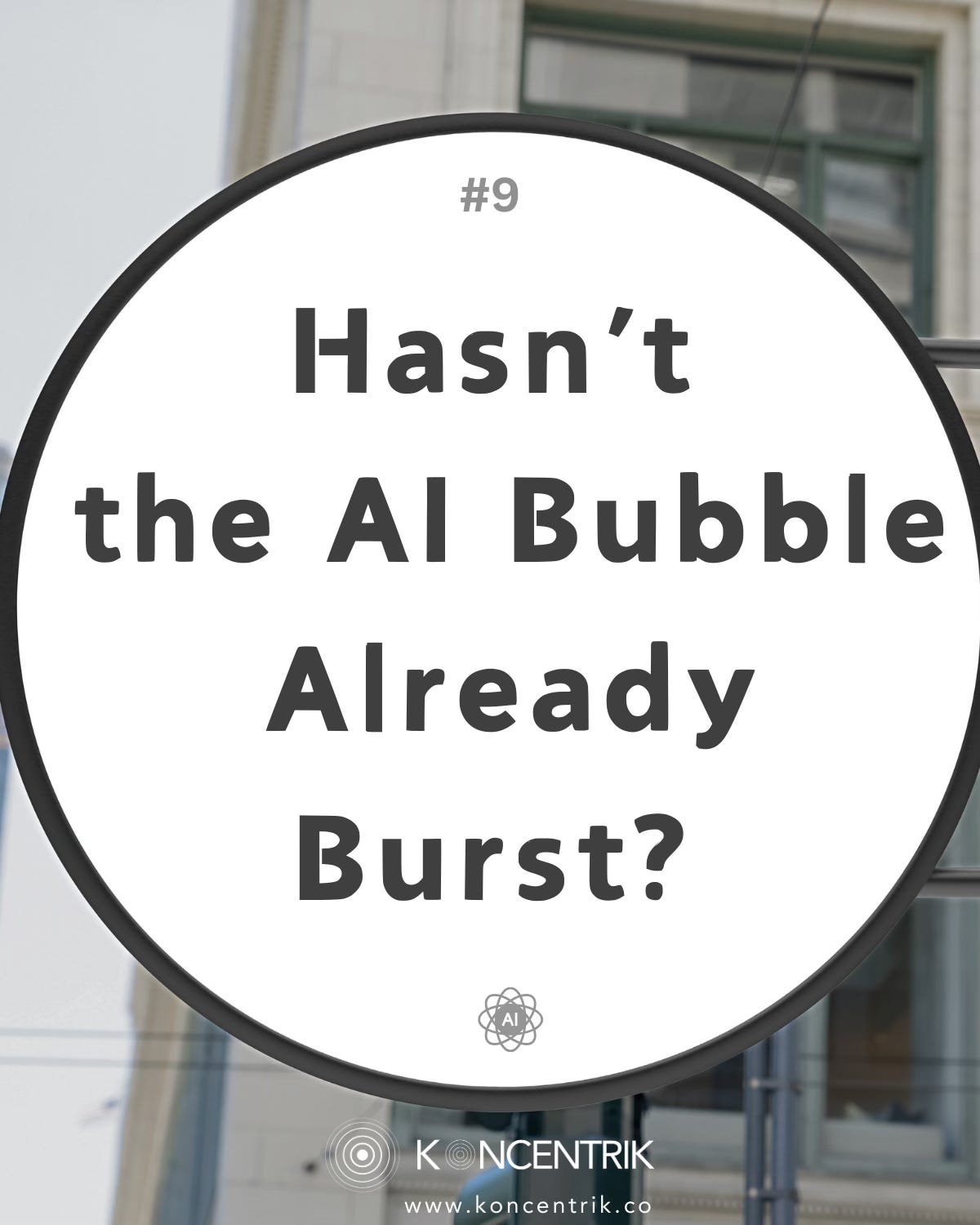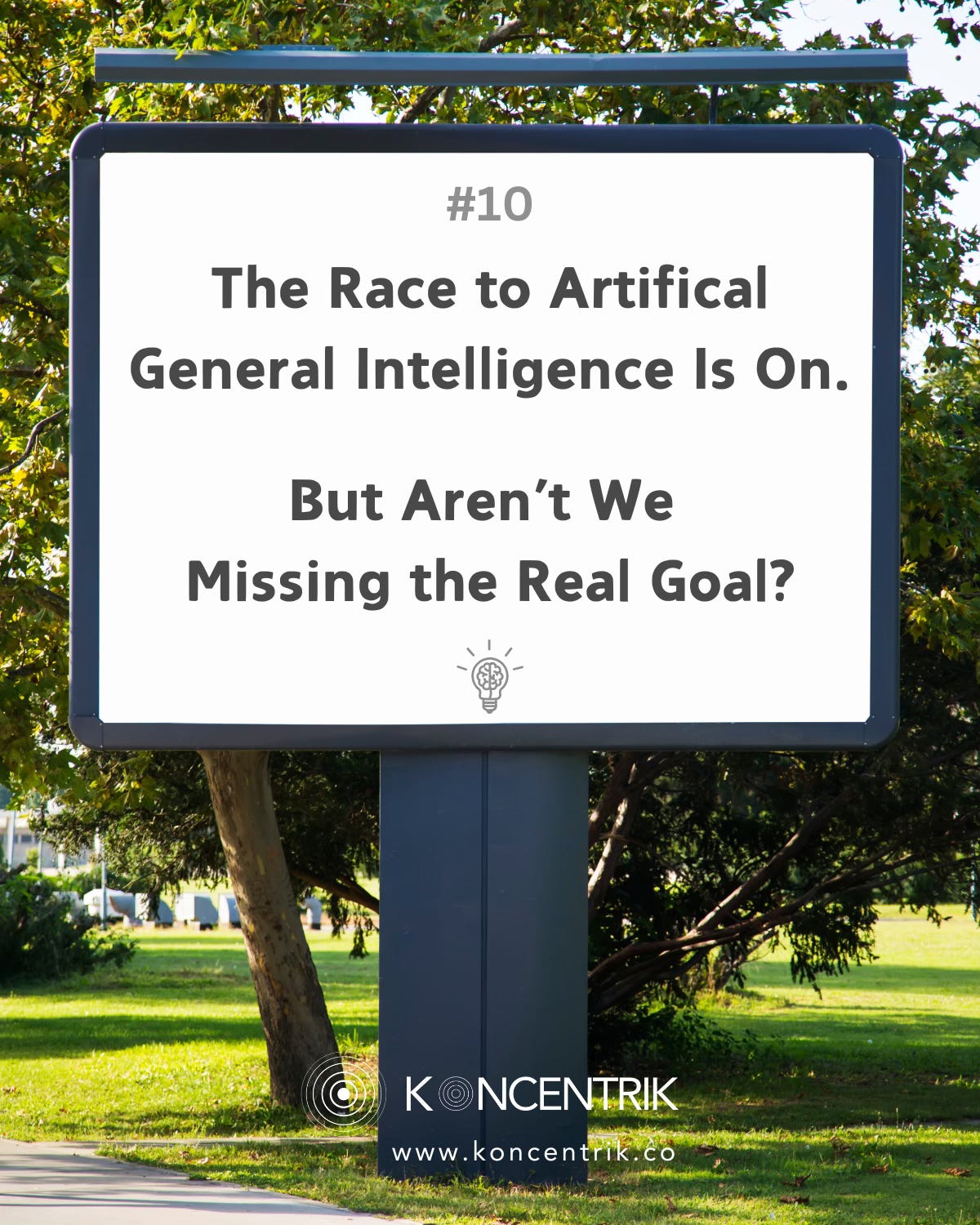2025 Tech Provocations
10 Really Uncomfortable Questions Leaders and Builders Must Answer This Coming Year
As we step into 2025, technological advancements, shifting priorities, and growing disillusions with old models. But this isn’t an inspiring tech vision. These aren’t predictions. These are just really annoying questions I’m sure you, leaders and builders, have at the back of your mind.
So let’s put them out there and start the conversation, shall we?
Executive Summary
1. Geo(politics) Are Reshaping Tech. Where Does Your Company Stand? Can your business uphold its values as technology becomes a tool and target in geopolitical and societal conflicts?
2. SaaS Platforms Are Dead. What’s Next? With the rise of decentralized systems, are traditional SaaS models at the brink of obsolescence?
3. Aren’t You Just Pretending to Care About Sustainability? Is sustainability part of your strategy, or just a box to tick?
4. Is Digital Transformation Draining Your Business Instead of Evolving It? Is transformation a destination, or should it be a continuous way of working?
5. Is Your Data Your Biggest Liability? How do you secure data when it’s both your most valuable asset and your greatest vulnerability?
6. Are You Innovating for the Future or the Next Quarter? How can you fight short-termism and focus on innovations that drive long-term value?
7. The Talent War Is On. Will Old Hiring Models Survive? How can we attract, reskill, and retain talent in a world where traditional employment models no longer work?
8. Your Innovation Initiatives Don’t Scale? Here is Why. Are proof-of-concept projects holding your organization back?
9. Hasn’t the AI Bubble Already Burst? What’s left after the AI hype?
10. The Race to AGI Is Pointless. Aren’t We Missing the Real Goal? Why are we chasing artificial general intelligence when better collective human intelligence is what we need?
Download the visuals here:
#1 Geo(politics) Are Reshaping Tech. Where Does Your Company Stand?
Can your business uphold its values as technology becomes both a tool and a target in geopolitical and societal conflicts?
The Shift
Geopolitics and societal pressures are profoundly reshaping the tech landscape. From semiconductor shortages fueled by U.S.–China tensions to bans on 5G infrastructure, tech decisions increasingly reflect political alignments. At the same time, societal pressures—on issues like data privacy, sustainability, and ethical AI—are forcing companies to navigate domestic and international politics simultaneously.
• Global military spending reached $2.24 trillion in 2022, with the U.S., China, and Russia accounting for 56% of it. This arms race extends to technology, particularly in AI and semiconductors. (https://www.statista.com/statistics/272494/longterm-changes-in-military-spending-in-highest-spending-countries/)
• 60% of customers expect CEOs to take a stand on societal and political issues. (https://www.edelman.com/trust/2022-trust-barometer)
The Opportunity
I believe this moment calls for more than risk management—it’s an opportunity to align your brand, stakeholders, and operations with a consistent, values-driven approach. Whether through activism or strategic neutrality, your company’s position can build resilience, differentiate your offerings, and establish trust with stakeholders.
Resolution Paths
1. Define Your Position: Decide if your company will adopt activism, neutrality, or a tailored balance between the two.
Activism Example: Patagonia’s environmental advocacy aligns with its brand and customer expectations.
Neutrality Example: Coca-Cola has focused on internal sustainability efforts while avoiding overt political stances, maintaining broad appeal across global markets.
2. Diversify Supply Chains: Reduce reliance on geopolitically sensitive regions.
Example: Apple’s shift of production from China to India and Vietnam demonstrates how companies can adapt to supply chain vulnerabilities.
3. Tailor Business Models to Local Contexts: Align operations with regional regulatory and cultural expectations.
Example: Microsoft’s EU-based data centers ensure compliance with local data sovereignty laws while building customer trust.
4. Communicate Transparently: Build trust by sharing the reasoning behind your decisions.
What you can do: Whether standing neutral or taking a stance, explain your strategy to employees, customers, and shareholders to avoid reputational risks.
5. Leverage Ethical Innovation: Use technology to uphold your values without polarizing stakeholders.
Example: Google’s investments in renewable energy projects align with its sustainability goals, demonstrating leadership on climate issues without engaging in divisive debates.
Geopolitics Demand Clarity
In today’s polarized world, your company’s position—activism, neutrality, or something in between—must be intentional, authentic, and aligned with your core values. Stakeholders expect consistency, and missteps can erode trust or loyalty.
Whether through ethical innovation, diversified supply chains, or bold stances on societal issues, successful companies will be those that navigate the geopolitical maze without losing sight of what matters most: their stakeholders and their values.
Where does your company stand? The time to define your position is now.
10 Readings to Explore Further
The Semiconductor Supply Chain and U.S.–China Relations: This RAND report discusses how geopolitical tensions between the U.S. and China are reshaping global supply chains, particularly in semiconductors, as nations strive to secure technological leadership and reduce vulnerabilities.
5G Technology and Global Power Dynamics: This article from the Global Risk Institute explores how 5G networks, big data, and AI are becoming arenas of geopolitical competition, particularly between democratic and authoritarian nations.
Artificial Intelligence (AI) and National Security: This RAND publication highlights how advancements in AI are influencing national security policies and the global balance of power, raising concerns about an AI arms race and the need for regulatory frameworks.
Japan’s Semiconductor Industry Resurgence: This Financial Times article outlines Japan’s efforts to reclaim semiconductor leadership through government-backed initiatives like Rapidus, aiming to diversify global chip manufacturing amid U.S.–China tensions.
Geopolitical Implications of Big Data: The Global Risk Institute report examines the strategic role of big data in geopolitics, highlighting its influence on decision-making, trade, and power dynamics between nations.
China’s Belt and Road Digital Infrastructure: This article explores China’s strategy of exporting digital infrastructure as part of its Belt and Road Initiative, fostering dependency on Chinese technology in emerging markets.
U.S. Export Controls on Chips: An analysis of U.S. export controls aimed at restricting China’s access to advanced semiconductors, with implications for the global tech supply chain and economic stability.
The Role of AI in Military Strategy: A NATO report on the integration of AI into military applications, raising questions about ethical deployment, strategic advantages, and risks of misuse in geopolitics.
The Splinternet and Global Digital Fragmentation: This Brookings Institution report examines the growing divide in global internet governance, driven by differing regulatory approaches and geopolitical tensions.
EU’s General Data Protection Regulation (GDPR) Impact: A case study on how Europe’s GDPR has influenced global data policies and forced companies to align operations with stricter privacy regulations.
#2 SaaS Platforms Are Dead. What’s Next?
With the emergence of agentic, distributed architectures powered by generative AI, are we witnessing the decline of traditional Software-as-a-Service (SaaS) platforms?
The Shift
Centralized SaaS platforms—once the backbone of modern business—are increasingly under scrutiny for their monopolistic tendencies and disproportionate control over user data, pricing, and content. Giants like Facebook (on privacy laws) and Google (on content ownership) have demonstrated the risks of centralized power.
Now, Decentralized Agent Networks (DANs) are emerging as a viable alternative. Powered by generative AI and blockchain, these systems promise Collaborative Task-as-a-Service (CTaaS) business models, where autonomous agents or teams of agents are assembled and hired to execute specific tasks. These agents can act, learn, and negotiate on behalf of users or organizations, enabling a more democratized and localized approach to digital services.
The Problem: SaaS Monopoly and Overreach
Revenue Capture: SaaS platforms capture up to 70% of profits in digital ecosystems, leaving limited value for businesses and consumers. (source: https://www.mckinsey.com)
Influence Over Policy: Big Tech companies spent $70 million lobbying U.S. Congress in 2022, shaping laws to their advantage. (source: https://www.statista.com/statistics/1112261/us-lobbying-spending-by-google-amazon-facebook/)
User Disillusionment: 61% of global users are concerned about the power and influence of Big Tech over their personal data and societal norms. (source: https://www.edelman.com)
The Opportunity: A Decentralized Future
Decentralized Agent Networks and CTaaS offer a solution by enabling autonomous, task-oriented systems. These systems bypass central authorities, allowing users to retain control of their data and digital interactions.
Autonomy: Users can own and control their digital identities and tasks, free from monopolistic platforms.
Collaboration: Multiple agents can dynamically assemble to complete complex jobs, offering flexibility and scalability.
Localization: Decentralized networks prioritize localized solutions tailored to specific user needs or regional contexts.
Why This Matters: The Beginning of a New Paradigm
The pivot to decentralized models could disrupt SaaS dominance and pave the way for new players who champion openness and collaboration:
$1.2 Trillion Market Shift: Generative AI is predicted to unlock $1.2 trillion in market value by 2030, with decentralized applications poised to capture a significant share. (source)
Blockchain Adoption: 81 of the world’s top 100 companies are now investing in blockchain, indicating growing interest in decentralization which may help power distributed agentic architectures. (source)
Customer Demand for Fairness: Over 50% of consumers want companies to use AI ethically and transparently. (source)
Resolution Paths
Experiment with CTaaS Architectures: Pilot distributed systems where autonomous agents can complete specific, collaborative tasks.
Example: Companies like Fetch.ai and SingularityNET are already pioneering agent-based ecosystems for supply chains and digital services.
Rethink Revenue Streams: Shift from traditional SaaS subscription models to transaction-based or commission-based models that incentivize collaboration.
Example: Platforms like Ocean Protocol monetize data-sharing transactions rather than centralizing data ownership.
Foster Open Ecosystems: Partner with decentralized networks to create interoperable solutions, avoiding the risks of obsolescence.
Example: Filecoin and IPFS (InterPlanetary File System) provide decentralized storage solutions, offering an alternative to centralized cloud platforms.
The Future of SaaS: A Collaborative, Decentralized Model
The rise of Decentralized Agent Networks and CTaaS marks a fundamental shift in how we think about digital services. Traditional SaaS platforms must adapt to prioritize user autonomy, collaboration, and transparency—or risk being left behind.
The question for leaders is : Will you embrace decentralization, or keep being at the mercy of monopolistic SaaS platforms?
10 Readings to Explore Further
Here are ten articles that delve into the evolution of SaaS platforms, the rise of generative AI agents, and the shift towards decentralized, agentic architectures:
1. The AI Agents Are Coming: This article discusses the emergence of AI agents capable of operating across various apps and digital services, signaling a shift from traditional SaaS models to more integrated AI solutions.
2. Microsoft AI Chief Mustafa Suleyman Says Conversational AI Is the Next Web Browser: An interview exploring how conversational AI is poised to become the new interface for web interactions, potentially disrupting existing SaaS platforms.
3. SingularityNET - Next Generation of Decentralized AI: An overview of SingularityNET, a decentralized platform that enables AI agents to collaborate and provide services, challenging centralized SaaS models.
4. What Is GaiaNet: A Decentralized and Incentivized GenAI Agents Network: An introduction to GaiaNet, a decentralized network offering secure, monetizable AI agents powered by individual expertise, representing a shift from traditional SaaS architectures.
5. Deagent: Decentralized Autonomous AI Agent Protocol: Information on Deagent, a blockchain network incentivizing creators of AI workers, promoting decentralized AI services over conventional SaaS offerings.
6. Decentralizing AI: An Overview: This article provides an overview of various decentralized AI ecosystems aiming to make AI training more accessible, indicating a move away from centralized SaaS platforms.
7. A Guide to AI Agents: What You Need to Know: An exploration of AI agents operating across decentralized networks, introducing new paradigms that could disrupt traditional SaaS models.
8. Decentralized Multi-Agent Actor-Critic with Generative Inference: A research paper discussing decentralized multi-agent systems with generative inference, contributing to the development of distributed AI architectures beyond SaaS.
9. He Helped Invent Generative AI. Now He Wants to Save It: An article about a pioneer in generative AI advocating for decentralized, open-source AI systems to counter the dominance of centralized platforms.
10. Race on to Build AI Tools That Talk to Each Other: This piece covers the development of interconnected AI tools capable of autonomous collaboration, potentially rendering traditional SaaS platforms obsolete.
#3 Aren’t You Just Pretending to Care About Sustainability?
Is sustainability part of your strategy, or just a box to tick?
The Shift
Consumers, investors, and regulators are demanding real, measurable action on sustainability. Companies that fall into the trap of greenwashing—making unsubstantiated claims—risk losing trust, facing regulatory penalties, and missing out on market opportunities.
• Greenwashing Backlash: 42% of consumers don’t trust brands’ sustainability claims. (https://www.bbc.com/news/business-57918260)
• Regulatory Pressure: The EU’s Corporate Sustainability Reporting Directive (CSRD) requires 50,000 companies to disclose detailed ESG impacts starting in 2024. (https://ec.europa.eu/)
• Consumer Preference: 72% of consumers say they are willing to pay more for sustainable products. (https://www.ibm.com/sustainability)
• Investment Impact: Companies with high ESG performance outperform peers by up to 10% annually. (https://www.mckinsey.com/business-functions/sustainability/our-insights/why-sustainability-is-a-new-driver-of-performance)
The Opportunity
True sustainability isn’t about ticking compliance boxes—it’s a strategic differentiator. Organizations that embed sustainability into core operations and tie it to revenue will gain a competitive edge, winning loyalty from eco-conscious consumers, employees, and investors.
Resolution Paths
Tie Sustainability to Revenue: Develop green products and services that command a premium price.
Example: Tesla’s electric vehicles not only initially disrupted the auto industry but also dominated the premium car market through innovation and sustainability. (https://www.tesla.com)
Set Transparent, Measurable Goals: Report on tangible sustainability benchmarks, such as carbon reduction, energy efficiency, and waste elimination.
Example: Unilever publishes its Sustainable Living Plan, tracking emissions, plastic usage, and responsible sourcing goals annually. (https://www.unilever.com/planet-and-society/)
Invest in Circular Economies: Design processes and products that minimize waste and maximize reuse.
Example: Adidas’ “Made to Be Remade” sneakers are fully recyclable, reinforcing a commitment to circular design.(https://www.adidas.com/us/sustainability)
Adopt Tech-Enabled Sustainability Solutions: Leverage AI, IoT, and blockchain to optimize energy usage, track supply chain emissions, and ensure accountability.
Example: Microsoft uses AI to reduce its data center carbon footprint and meet its goal of being carbon-negative by 2030. (https://news.microsoft.com/climate)
Make Sustainability Personal: Engage employees and customers in sustainability initiatives to create shared ownership of outcomes.
Example: Patagonia’s “Don’t Buy This Jacket” campaign encouraged customers to repair and reuse products, aligning purpose with action. (https://www.patagonia.com/stories/reduce-repair-reuse-recycle/story-17991.html)
Why It Matters
Companies that merely pretend to care about sustainability will fall behind. Greenwashing erodes trust and invites backlash, while authentic efforts strengthen long-term brand loyalty and resilience.
• Risk of Inaction: Over $4.2 trillion in assets are at risk from environmental damage if companies don’t adapt to climate demands. (https://www.weforum.org/agenda/2023/01/the-business-case-for-sustainability/)
• Employee Expectations: 73% of employees want to work for companies that prioritize sustainability. (https://www.pwc.com/gx/en/sustainability)
The choice is clear: embed sustainability into your strategy, or risk being left behind by consumers, investors, and regulators demanding real progress.
The Question for Leaders and Builders: Is sustainability part of your company’s DNA, or just a marketing checkbox? In 2025, the companies that act authentically and transparently will be the ones that earn trust, loyalty, and long-term success.
10 Readings to Explore Further
1. BBC on Greenwashing Backlash: This article discusses the growing backlash against greenwashing, where companies exaggerate or mislead consumers about their environmental efforts. It highlights consumer skepticism and the risks of being caught making false sustainability claims.
2. IBM Report on Consumer Willingness to Pay More for Sustainability: IBM’s research reveals that 72% of consumers are willing to pay a premium for sustainable goods and services. It underscores the business case for aligning sustainability with customer demand and revenue growth.
3. McKinsey on ESG Outperformance: McKinsey’s analysis shows that companies with strong ESG (Environmental, Social, and Governance) performance achieve up to 10% higher financial returns, making sustainability a critical driver for competitive advantage.
4. Patagonia Case Study: Reduce, Repair, Reuse: Patagonia’s iconic campaign “Don’t Buy This Jacket” encourages consumers to repair, reuse, and recycle their products. It highlights the brand’s commitment to sustainability through circular economy principles.
5. EU Corporate Sustainability Reporting Directive (CSRD): This page provides details on the EU’s CSRD, which mandates that over 50,000 companies disclose their environmental, social, and governance performance, driving transparency and accountability in sustainability.
6. World Economic Forum on Trillions at Risk: This report outlines the $4.2 trillion in global assets at risk due to environmental damage, emphasizing the financial imperative for businesses to adopt sustainable practices.
7. Microsoft’s Carbon Negative Goal: Microsoft outlines its ambitious goal to become carbon negative by 2030, using AI to optimize energy efficiency, reduce emissions, and invest in renewable energy solutions.
8. Adidas Circular Economy Initiative: Adidas’ “Made to Be Remade” sneakers are fully recyclable, supporting a circular economy model and reducing waste, while promoting sustainable innovation in product design.
9. PWC Report on Employee Expectations for Sustainability: This PWC report reveals that 73% of employees prefer to work for companies that prioritize sustainability, highlighting the role of ESG efforts in attracting and retaining talent.
10. Unilever’s Sustainable Living Plan: Unilever details its sustainability strategy, reporting progress on carbon emissions, responsible sourcing, and reducing plastic waste, setting a benchmark for corporate transparency.
#4 Is Digital Transformation Draining Your Business Instead of Evolving It?
Is transformation a destination, or should it be a continuous way of working?
The Shift
Many companies are overwhelmed by endless transformation initiatives that promise much but deliver little. For example, 38% of business leaders would rather quit than manage another major change program. (https://www.thetimes.co.uk/article/what-i-learnt-about-working-through-change-fatigue-enterprise-network-bzncczrvc).
I wrote before about the concept of “upvolution” as the idea that embracing the NEW means getting an organization ready to evolve constantly while upgrading its systems. Change and adaptation is a way of working, it’s not about moving from A to B.
So I believe the future is about upvolution—continuous, iterative improvements rather than disruptive overhauls. This approach minimizes risk and allows organizations to adapt gradually. (https://mccricardo.com/the-merits-of-iterative-progress-over-big-bang-changes/)
The Opportunity
I often say I like to work with smart but lazy people: because smart and lazy people always find a way to get things done faster and focus on outcomes first!
Adopting a “work smarter, not harder” mindset can help organizations manage change without burning out employees or straining resources. Leaders who focus on communication, alignment with strategy, and employee empowerment will build resilient organizations. (https://blogs.idc.com/2024/04/10/strategies-to-combat-the-effects-of-digital-transformation-fatigue/)
Resolution Paths
Focus on Iteration:
Break transformation into smaller, more manageable goals to reduce disruptions. (https://www.jordanalliance.com/post/choosing-the-right-implementation-method-big-bang-vs-phased)Embed Change Into Culture:
Foster a mindset of continuous improvement, treating transformation as an ongoing journey. (https://blogs.idc.com/2024/04/10/strategies-to-combat-the-effects-of-digital-transformation-fatigue/)Align Technology With People:
Prioritize changes employees can realistically absorb by providing proper training and support. (https://www.soocial.com/digital-transformation-failure-statistics/)
The Takeaway:
Digital transformation should be a journey, not a destination. Leaders who prioritize manageable, iterative changes will drive meaningful progress without overwhelming their teams.
Where does your company stand in its transformation journey?
10 Readings to Explore Further
What I Learnt About Working Through Change Fatigue
A Times article explores how change fatigue impacts business leaders and employees, emphasizing the need for smarter transformation strategies.
https://www.thetimes.co.uk/article/what-i-learnt-about-working-through-change-fatigue-enterprise-network-bzncczrvcThe Merits of Iterative Progress Over Big-Bang Changes
This article explains why gradual, incremental changes often outperform large, disruptive transformations.
https://mccricardo.com/the-merits-of-iterative-progress-over-big-bang-changes/Strategies to Combat the Effects of Digital Transformation Fatigue
IDC provides actionable insights into managing transformation fatigue through communication, employee engagement, and realistic goals.
https://blogs.idc.com/2024/04/10/strategies-to-combat-the-effects-of-digital-transformation-fatigue/Choosing the Right Implementation Method: Big Bang vs. Phased
This article discusses the pros and cons of implementing big-bang vs. phased transformation strategies.
https://www.jordanalliance.com/post/choosing-the-right-implementation-method-big-bang-vs-phasedDigital Transformation Failure Statistics
A compilation of statistics that highlight the common pitfalls of digital transformation efforts.
https://www.soocial.com/digital-transformation-failure-statistics/16 Digital Transformation Statistics for 2024
Backlinko provides data on digital transformation trends and adoption rates globally.
https://backlinko.com/digital-transformation-statsTop 65+ Digital Transformation Statistics in 2024
A comprehensive guide to global digital transformation metrics, including market growth and adoption barriers.
https://doit.software/blog/digital-transformation-statistics45+ Key Digital Transformation Statistics (2025)
Exploding Topics explores key data points, including how businesses are advancing in their transformation journeys.
https://explodingtopics.com/blog/digital-transformation-stats72 Vital Digital Transformation Statistics
This article outlines spending trends, adoption challenges, and success metrics for transformation projects.
https://financesonline.com/digital-transformation-statistics/85+ Digital Transformation Stats From Reputable Sources
AI Multiple provides an extensive list of verified statistics on digital transformation and its market impact.
https://research.aimultiple.com/digital-transformation-stats/
#5 Is Your Data Your Biggest Liability?
How do you secure data when it’s both your most valuable asset and your greatest vulnerability?
The Shift: Treating Data as Both an Asset and a Risk
In an era where cyberattacks are becoming increasingly sophisticated and pervasive, every piece of data carries inherent risk. For organizations, the challenge lies in safeguarding their treasure troves of information while leveraging them for competitive advantage. This dynamic has compelled leaders to adopt a mindset where data is viewed as a liability first, then an asset.
The rise of data as a liability aligns with my earlier discussions on AI governance and privacy challenges. As I outlined in my series on augmenting humans with technology, the responsible handling of data is crucial to mitigating risks while driving innovation .
The Opportunity: Data-Driven Risk Mitigation
By acknowledging data as a potential liability, businesses can establish policies that emphasize smarter collection, storage, and usage strategies. Organizations that proactively manage data risks are better positioned to enhance trust, reduce regulatory exposure, and maintain operational resilience.
Key to this approach is data minimization. Instead of hoarding data indiscriminately, collect and retain only what is essential for operational success. This not only limits exposure in the event of a breach but also reduces the costs associated with data management.
This perspective ties back to my article on AI risk-reward models, where I detailed how data providers and consumers could balance risk and reward effectively .
Resolution Paths: Strategies to Mitigate Data Risks
1. Adopt Zero-Trust Security
Zero-Trust Security is a framework that assumes breaches are inevitable. It involves verifying each access request and minimizing privileges to only what is necessary. This ensures that even if a breach occurs, its impact is limited. As I noted in my reflections on AI deployment in physical environments, securing the digital periphery is as important as safeguarding the core .
2. Embrace Data Minimization
The more data you collect, the higher your liability. This principle is not new, but in the age of Big Data, it bears repeating. In my piece on finding the right AI model, I emphasized the importance of precise data usage tailored to specific business problems .
3. Use Privacy-Enhancing Technologies
Encryption, anonymization, and advanced tokenization techniques are now essential for securely sharing and storing data. These technologies enable organizations to collaborate without exposing sensitive information. My series on Digital Upvolution highlighted the role of such technologies in creating a connected, yet secure, world .
Conclusion
Data’s dual role as a vital asset and significant liability is reshaping how businesses approach governance, innovation, and growth. Organizations must pivot from reactive to proactive strategies, treating data risks as opportunities for differentiation. This approach not only secures the enterprise but also builds trust with customers and stakeholders—a key theme I explored in the context of service productization and intellectual capital development .
10 Readings to Go Further
1. NIST Cybersecurity Framework: Comprehensive guidelines for managing and reducing cybersecurity risks.
2. GDPR Insights: An overview of Europe’s General Data Protection Regulation and its implications for data management.
3. Zero Trust Framework: Microsoft’s guide to implementing Zero Trust principles.
4. AI Risk Management: Google’s approach to managing AI and data-related risks.
5. Understanding Data Breaches: Learn about historical data breaches and their implications.
6. Privacy Enhancing Technologies: IBM’s insights into encryption and anonymization.
7. Data Minimization Principles: ISO’s guidelines for data minimization practices.
8. The Cybersecurity Tech Accord: A coalition aiming to protect users from malicious online activities.
9. Data Ethics and AI: World Economic Forum’s articles on balancing data innovation and ethics.
10. AI Risk/Reward Dynamics: Explore insights on the AI value chain and data’s role within it .
#6 Are You Innovating for the future of the next quarter?
How can you fight short-termism and focus on innovations that drive long-term value?
The Shift
Many organizations are trapped by the tyranny of quarterly metrics, prioritizing immediate wins at the expense of sustainable growth. This short-term focus discourages bold, transformative innovation and leaves companies vulnerable to disruption.
• Pressure to Meet Quarterly Goals: 55% of executives admit short-term pressures conflict with long-term strategies according to McKinsey
• Lack of Focus on Long-Term Innovation: Only 29% of leaders say their companies are effective at pursuing transformative innovation according to BCG.
The Opportunity
Breaking free from short-termism can unlock transformative growth. Organizations that align innovation efforts with long-term impact build resilience, attract top talent, and create sustainable competitive advantages.
• 81% of executives believe companies should prioritize long-term value creation, but only 40% feel equipped to do so (McKinsey)
• Companies that focus on long-term strategies generate 47% higher revenue growth than peers focused on short-term goals (Forbes)
• 60% of employees say their companies’ focus on immediate results demotivates them from pursuing innovative ideas (McKinsey)
Resolution Paths
1. Redefine Success Metrics: Measure success by long-term outcomes, such as market share growth, environmental impact, or customer loyalty, rather than quarterly revenue.
Example: Amazon’s strategy focuses on reinvestment for market dominance, delaying profitability to prioritize customer experience and innovation.
2. Invest in Moonshots: Dedicate resources to high-risk, high-reward projects that could shape the future.
Example: Google’s X division (formerly Google X) invests in projects like self-driving cars and internet balloons, with the potential for massive societal and financial returns.
3. Build Resilience Into Business Models: Focus on innovations that help organizations adapt to future challenges and disruptions.
Example: Tesla’s innovations in battery technology and renewable energy solutions prepare it for a sustainable future, beyond electric vehicles.
Conclusion
Innovation for the future requires bold thinking, clear metrics, and a willingness to take risks. The question is, will your organization focus on lasting impact or fall into the trap of chasing the next quarter’s results?
10 Readings to Go Further
McKinsey: Short-Term Pressures vs. Long-Term Value: Discusses the conflict between short-term pressures and long-term strategies, offering insights on aligning leadership priorities.
BCG: Driving Transformative Innovation: Explores why organizations struggle to prioritize long-term innovation and offers frameworks to encourage transformative efforts.
Forbes: Long-Term Strategy and Revenue Growth: Highlights the financial benefits of long-term strategies, with case studies of companies that outperform short-term-focused peers.
Harvard Business Review: The Demotivation of Short-Termism: Examines how short-termism impacts employee engagement and creativity, leading to missed innovation opportunities.
Amazon’s Long-Term Strategy: Explains Amazon’s reinvestment philosophy and its success in prioritizing long-term customer and market dominance over short-term profits.
Google X: Moonshot Factory: Details Google X’s approach to high-risk, high-reward projects that aim to solve big societal challenges.
Tesla’s Resilience Model: Highlights Tesla’s strategy of innovating in renewable energy and battery technology to ensure long-term growth.
EY: Sustainable Long-Term Innovation: Discusses how sustainability can drive innovation and create long-term value for companies and stakeholders.
World Economic Forum: The Innovation Imperative: Examines the role of innovation in addressing global challenges and the importance of long-term thinking.
Deloitte: Balancing Innovation and Short-Term Goals Provides practical advice on managing short-term pressures while investing in long-term innovation initiatives.
#7 The Talent War Is On. Will Old Hiring Models Survive?
How can we attract, re-skill, and retain talent in a world where traditional employment models no longer work?
The Shift
The competition for talent is no longer about simply offering higher salaries or better perks. Today’s workforce prioritizes flexibility, purpose, and development opportunities. Traditional, rigid employment models are failing to meet these expectations, driving companies to adopt more dynamic approaches.
• Workforce Expectations: A 2023 survey revealed that 56% of employees value flexibility as much as salary when choosing a job. (https://www.weforum.org/)
• Demand for Remote Work: 74% of professionals believe remote or hybrid work options are critical to retaining talent. (https://www.gartner.com/)
• Freelancer Ecosystem Growth: The freelance workforce in the U.S. grew to 39% in 2022, with many professionals opting for the flexibility and autonomy of project-based work. (https://www.upwork.com/)
• Shift to Purpose-Driven Work: A study by McKinsey shows that 70% of employees want meaningful work aligned with their values, making purpose a key differentiator in the talent war. (https://www.mckinsey.com/)
These statistics illustrate that employers must go beyond traditional incentives, creating work environments that align with modern workforce demands for autonomy, flexibility, and meaningful engagement.
The Opportunity
Embracing adaptable structures offers companies a chance to attract, develop, and retain top talent while enhancing agility and responsiveness. Dynamic environments empower employees to transition seamlessly across roles, making organizations more resilient and competitive.
• Agility Through Talent Fluidity: Companies with dynamic talent allocation practices, such as project-based roles and cross-functional teams, report a 25% boost in productivity and improved employee satisfaction (https://www.mckinsey.com/)
• Retention Through Reskilling: Organizations that prioritize upskilling programs are 2.9 times more likely to retain employees. (https://www.gartner.com/)
• Impact on Revenue Growth: Businesses that adopt flexible work models achieve 21% higher profitability, driven by improved employee engagement and retention. (https://www.forbes.com/)
• Fractional Leadership on the Rise: The use of fractional roles has grown by 32% year-over-year, allowing companies to tap into specialized expertise without full-time commitments. (https://www.hbr.org/)
These opportunities highlight the potential for forward-thinking companies to build talent ecosystems that not only attract top performers but also adapt to future workforce and market demands. By focusing on flexibility and dynamic talent strategies, organizations position themselves as leaders in the evolving world of work.
The Takeaway
The rules of the talent game have changed. Offering competitive salaries is no longer enough to attract or retain top performers. Today’s workforce demands flexibility, purpose, and growth opportunities—and organizations that fail to adapt risk falling behind.
By embracing flexible work models, dynamic talent allocation, and continuous upskilling, companies can:
• Build resilient, future-proof teams that adapt to evolving business needs.
• Boost employee satisfaction, engagement, and retention.
• Gain a competitive edge in the fierce war for talent.
The question for leaders is clear: Are you ready to let go of outdated hiring models and embrace the future of work? Those who do will unlock innovation, agility, and long-term success!💡
10 Readings to Go Further:
1. Davos 2024: 6 Ideas on Reskilling and the Future of Work: Highlights innovative approaches to reskilling and upskilling in response to the evolving job market.
2. Fractional Leadership Teams: When and Why You Should Build One: Explores the benefits and considerations of assembling fractional leadership teams to enhance organizational flexibility.
3. The Future of Work: Reskilling and Remote Working to Recover in the Next Normal: Analyzes the importance of reskilling and remote work in adapting to post-pandemic business environments.
4. Reskilling: The Imperative Strategy for Navigating the Future of Work Amidst Technological Disruption: Discusses the necessity of reskilling strategies to navigate technological advancements and workforce disruptions.
5. Understanding 6 Models of Fractional Leadership: Provides insights into various models of fractional leadership and their applications in modern organizations.
6. The Future of Work Revolves Around Talent: Examines how talent management is central to future work strategies and organizational success.
7. Four Ways that Fractional Leadership is Transforming a Resource-Starved Market: Highlights how fractional leadership addresses resource constraints and drives business growth.
8. Dynamic Talent Allocation and the Future of Work: Explores the role of dynamic talent allocation in shaping the future workplace and enhancing agility.
9. The Rise of Fractional Leadership: Why More Organizations are Turning to Flexible Solutions: Analyzes the increasing adoption of fractional leadership and its benefits for organizational flexibility.
10. Beyond Hiring: How Companies are Reskilling to Address Talent Gaps: Discusses how organizations are implementing reskilling programs
#8 Your Innovation Initiatives Don’t Scale? Here is Why
Scaling innovation from proof-of-concept (POC) to full implementation is a significant challenge for many organizations. Understanding the dynamics of this process is crucial for leaders aiming to maximize the impact of their innovative initiatives.
The Shift
Many organizations initiate POCs to test new ideas, but a substantial number fail to transition these projects into full-scale operations. Gartner predicts that by 2025, at least 30% of generative AI projects will be abandoned after the POC phase due to issues like poor data quality, escalating costs, or unclear business value.(https://www.gartner.com)
• Failure Rates: A study by McKinsey found that 70% of digital transformation efforts fail to meet their objectives, with many projects stalling after the POC stage. (https://www.mckinsey.com)
• Lost Investments: IBM estimates that 50% of AI initiatives fail to go beyond the POC phase, leading to billions in wasted investments. (https://www.ibm.com)
• Organizational Misalignment: According to Deloitte, 42% of organizations cite lack of cross-departmental collaboration as the main reason POCs fail to scale. (https://www2.deloitte.com)
To be clear though: POCs provide a great deal of learnings and by design, a number of them should fail so they provide the foundations for others to succeed. The issue is when too many POCs fail for the wrong reasons, such as:
poor business case / weak use case
reliance on one off subsidies / innovation grants
no real ambition / poor leadership endorsement and support
lack of resources commitment or budget
no success criteria defined upfront (doomed to fail)
The above issues are preventable and could be identified earlier to maximise chances of success (whatever the definition of success is!).
Our success at Amazon is a function of how many experiments we do per year, per month, per week, per day. - Jeff Bezos, Amazon
Organisations need to build their innovation muscles Eg. their ability to experiment quickly and cheaply to learn fast and identify winning ideas so they can be scaled.
The Opportunity
Successfully scaling innovation requires deliberate strategy, early commitment, and cross-departmental collaboration. Leaders who prioritize scaling not only amplify their return on investment but also build sustainable competitive advantages.
• Return on Investment: Companies that successfully scale innovations see a 30% higher ROI compared to those that repeatedly run new POCs without scaling. (https://hbr.org)
• Cross-Functional Teams: Organizations with dedicated scaling teams achieve a 20% higher success rate in scaling projects. (https://www.gartner.com)
• Outcome-Focused Metrics: Research shows that companies measuring outcomes instead of outputs report 15% more impactful innovations. (https://www.forbes.com)
• Commitment to Funding: A study by MIT Sloan highlights that companies allocating at least 10% of innovation budgets to scaling are significantly more likely to succeed. (https://mitsloan.mit.edu)
These opportunities underline the importance of integrating scaling strategies into innovation planning from the outset.
Resolution Paths
1. Commit to Scaling Early: Identify and allocate resources to promising POCs early in their development to ensure momentum is maintained.
2. Create Dedicated Scaling Teams: Establish teams responsible for transitioning successful pilots into full-scale operations, ensuring focus and accountability.
3. Measure Outcomes, Not Outputs: Concentrate on the impact and value delivered by scaled initiatives rather than merely their novelty or activity levels.
Takeaway
Leaders must recognize that the journey from POC to scalable innovation is fraught with challenges but also ripe with opportunity. To succeed, organizations need:
• Early Commitment: Align resources and strategies with scaling from the start.
• Dedicated Teams: Invest in cross-functional teams to champion scaling efforts.
• Outcome-Driven Metrics: Focus on measurable business value instead of just novelty.
This strategic approach not only maximizes resource utilization but also enhances the likelihood of achieving sustainable, impactful growth through innovation.
10 Readings To Go Further
1. AI Project Failure Rates Near 50%, But It Doesn’t Have to Be That Way: The Wall Street Journal Explores the high failure rates of AI projects and strategies to improve success through alignment with business goals.
2. 5 Ways to Successfully Scale Digital Initiatives: MIT Provides strategies to overcome barriers in scaling digital innovations.
3. Three Strategies For Successfully Innovating At Scale: Forbes: Offers practical advice on removing silos and fostering collaboration for large-scale innovation.
4. Scaling Innovation – The What, Why, and How:Viima: Explains the dimensions of scaling innovation, including scaling up, scaling out, and scaling deep.
5. Why Do Most AI Projects Fail?:Forbes: Analyzes common pitfalls in AI project implementation and offers guidance for effective scaling.
6. Unlock your organization’s AI value: From proof of concept to real impact:Thoughtworks: Examines challenges and strategies for scaling AI projects.
7. Scaling Out, Scaling Up, Scaling Deep McConnell Foundation: Discusses strategies for scaling innovations and achieving greater impact.
8. From Proof of Concept to Scalable Policies: Challenges and Solutions MIT Economics: Highlights obstacles in scaling small-scale experiments and offers policy scaling solutions.
9. “Scaling Innovation – The What, Why, and How” Really Good Innovation: Insights into the process and considerations for successful scaling.
10. Scaling of Innovations Cap Gemini: Capgemini report finds that some organizations have made significant strides to streamline processes to supercharge scaling innovation efforts by nearly two years but others still fail to scale.
#9 Hasn’t the AI Bubble Already Burst?
What’s left after the AI hype?
The Shift
The industry is slowly moving beyond inflated expectations, focusing instead on practical applications that solve real-world problems. The era of unchecked excitement is giving way to a more pragmatic approach.
• Data Quality Concerns: In 2024, Gartner emphasized that improving training data is crucial for achieving better AI outcomes, urging organizations to adopt a data-centric approach. (https://www.gartner.com/en/articles/what-s-new-in-artificial-intelligence-from-the-2023-gartner-hype-cycle)
• Investment Trends: AI start-ups raised $42.5 billion in 2023, representing a 10% decline from the previous year, signaling a more cautious investment environment. (https://www.onlinebusinessstartup.co.uk/blog/bursting-the-bubble-analysing-the-current-state-of-the-ai-industry)
• Regulatory Scrutiny: The European Central Bank has warned about a potential “bubble” in AI stocks, suggesting that unmet earnings expectations could disrupt global markets. (https://futurism.com/the-byte/alarms-ai-bubble)
The Opportunity
Organizations that adopt a pragmatic approach to AI can unlock significant operational improvements and customer satisfaction, focusing on what truly matters—value creation.
• Operational Efficiency: AI-driven automation is reshaping industries, with 70% of organizations planning to invest in AI and automation for customer service in the coming year. (https://fluentsupport.com/ai-customer-service-statistics)
• Enhanced Customer Experience: AI-powered personalization has improved interactions, with 63% of retail organizations actively using AI to enhance customer service. (https://www.cmswire.com/customer-experience/10-ai-customer-experience-statistics-you-should-know-about)
• Cost Reduction: 60% of customer support leaders expect AI to help lower support costs within the next five years. (https://fluentsupport.com/ai-customer-service-statistics)
Resolution Paths
1. Fix Your Data: Prioritize data cleaning, governance, and accessibility to ensure accurate and actionable insights.
2. Automate Meaningfully: Automate repetitive tasks, allowing employees to focus on higher-value, strategic decisions.
3. Create Better Products: Leverage AI to enhance user experiences and solve real customer pain points.
Takeaway
The days of AI hype are (almost?) over, but the opportunity for meaningful impact remains strong. To thrive in this new era, leaders should:
• Prioritize Data Quality: Build robust systems that support accurate, unbiased data.
• Strategically Automate: Focus on areas where automation creates efficiency without compromising quality.
• Focus on Customer-Centric Development: Use AI to enhance products and services that directly address customer needs.
By focusing on these fundamentals, organizations can move beyond the hype to achieve sustainable growth and tangible results.
10 Readings To Go Further
1. Hype Cycle for Artificial Intelligence 2024 Gartner: Analyzes AI technology maturity, highlighting practical applications over hype.
2. Bursting Bubble: Analyzing the Current State of the AI Industry Online Business Startup: Discusses investment trends and AI industry realities.
3. AI Can Take the Slog Out of Compliance Work, but Executives Not Ready to Fully Trust It The Wall Street Journal: Explores challenges in adopting AI for compliance.
4. The AI ‘Bubble’ Has Helped the U.S. Stock Market Dominate the World. What Happens if It Bursts? Morningstar: Discusses how the AI investment bubble could impact global markets.
5. The AI Hype Cycle: Where Are We Now and What’s Next? Lab4AI: Examines AI’s current state and future projections.
6. Beyond the Hype: Capturing the Potential of AI and Gen AI in Tech McKinsey & Company: Discusses leveraging AI’s potential for meaningful innovation.
7. AI Hype vs Reality: What’s All This Hype With AI? Blue Prism: Differentiates between AI’s realistic capabilities and exaggerated claims.
8. The AI Bubble Is Bursting, Experts Say Futurism: Highlights expert opinions on the decline of AI hype.
9. Artificial Intelligence in Business - Statistics & Facts Statista: Comprehensive data on AI’s role in business.
10. The AI Revolution Is Already Losing Steam The Wall Street Journal: Examines the slowdown in AI advancements and market shifts.
#10 The Race to Artificial General Intelligence Is On. But Aren’t We Missing the Real Goal?
The pursuit of Artificial General Intelligence (AGI) has garnered significant attention and investment, with tech giants like OpenAI, Anthropic, and Google leading the charge. However, I believe this focus on achieving AGI may overlook the immediate benefits of enhancing collective human intelligence through AI augmentation.
Recently, OpenAI unveiled its latest AI model, o3, designed to enhance reasoning capabilities. The o3 model has demonstrated significant improvements in complex tasks, including coding, mathematics, and science, achieving record-breaking scores on benchmarks like the ARC-AGI, with an 87.5% accuracy rate in high-compute scenarios (https://www.wired.com/story/openai-o3-reasoning-model-google-gemini/). This advancement underscores the rapid progress in AI development, yet it also highlights the ongoing debate about the ultimate goals of AI research.
The Shift:
The race to develop AGI has led to substantial financial commitments. Investment in artificial intelligence (AI) has surged significantly in 2024, reflecting the technology’s growing importance across various sectors. Key highlights include:
• Total Funding: AI and cloud companies in the U.S., Europe, and Israel are projected to receive $79.2 billion by the end of 2024, marking a 27% increase from 2023.
• Generative AI Focus: Approximately 40% of this funding is directed toward generative AI startups, emphasizing the industry’s interest in AI models capable of creating content autonomously.
• Venture Capital Involvement: In the U.S., AI investments constitute about 33% of total venture capital funding in 2024, highlighting the sector’s prominence among investors.
• Notable Funding Rounds:
• OpenAI secured $10.6 billion in 2024, bringing its total funding to $21.9 billion.
• Anthropic raised $2.1 billion this year, totaling $9.7 billion in funding.
• Databricks achieved a $62 billion valuation following a substantial funding round.
The global human augmentation market, which focuses on using technology to improve human abilities, is projected to grow from $131.7 billion in 2021 to $341.2 billion by 2026 (https://julienflorkin.com/technology/transhumanism/human-augmentation/).
The Opportunity:
By shifting focus from AGI to AI-driven human augmentation, organizations can achieve immediate and tangible benefits.
AI can assist in decision-making and problem-solving processes, analyzing vast amounts of data to provide recommendations that aid professionals in making well-informed choices (https://hitricks.com/ai-human-augmentation/).
Additionally, AI-powered personalization has improved interactions, with 63% of retail organizations actively using AI to enhance customer service (https://newatlas.com/technology/ai-index-report-global-impact/).
Investing in AI that complements human intelligence can lead to improved productivity, better decision-making, and enhanced customer experiences.
Resolution Paths:
1. Develop AI for Augmentation: Prioritize AI systems that enhance human decision-making and creativity, rather than replacing them.
2. Foster Human-AI Collaboration: Build systems where humans remain in control, empowered by AI to perform tasks more efficiently.
3. Focus on Education: Upskill employees to work seamlessly with advanced technologies, ensuring they can leverage AI tools effectively.
Takeaway:
Leaders should recognize that while the pursuit of AGI is ambitious, the immediate benefits of AI lie in augmenting human intelligence. By focusing on AI applications that enhance human capabilities, organizations can achieve significant improvements in productivity and decision-making.
10 Readings To Go Further:
1. Artificial General Intelligence Report TrendFeedr: An overview of AGI research, funding trends, and industry engagement. https://trendfeedr.com/reports/artificial-general-intelligence-report/
2. Artificial General Intelligence (AGI) Market Share, 2032 Business Research Insights: Insights into the AGI market, including key players and challenges. https://www.businessresearchinsights.com/market-reports/artificial-general-intelligence-agi-market-117873
3. AI now surpasses humans in almost all performance benchmarks New Atlas: A report on AI’s advancements and its implications across various sectors.
https://newatlas.com/technology/ai-index-report-global-impact/
4. Artificial General Intelligence [AGI] Market Size, 2024-2032 SNS Insider: Analysis of the AGI market’s projected growth and regional insights. https://www.snsinsider.com/reports/artificial-general-intelligence-market-4174
5. AI Can Actually Make Us Better: The Case for AI-Driven Human Augmentation Techopedia: Exploration of how AI can enhance human capabilities and the rise of human augmentation. https://www.techopedia.com/ai-can-actually-make-us-better
6. 2024 Emerging Space Brief: AGI Research PitchBook: A primer on AGI research, including key applications and market outlook. https://pitchbook.com/news/reports/2024-emerging-space-brief-agi-research
7. Human Augmentation Technology - Benefits and Real Examples Appinventiv: Discussion on human augmentation technology and its applications across industries. https://appinventiv.com/blog/human-augmentation-technology/
8. Artificial General Intelligence - The Millennium Project The Millennium Project: A comprehensive paper on AGI issues and opportunities. https://www.millennium-project.org/wp-content/uploads/2023/05/EC-AGI-paper.pdf
9. AI and Human Augmentation: Enhancing Human Capabilities with Artificial Intelligence HiTricks: Insights into AI-powered human augmentation and its benefits. https://hitricks.com/ai-human-augmentation/
10. 5 Startups Investing in AGI Research in the U.S AIM Research: Profiles of startups focusing on AGI research and their funding details. https://aimresearch.co/market-industry/5-startups-investing-in-agi-research-in-the-u-s
Final Thoughts
I would like 2025 to not be just about keeping up with change — but about leading it!
I hope these provocations can push us to rethink our assumptions, embrace change, and take bold actions to create the NEW.
Final Provocations:
• What assumptions are we making about the future? (What else but AI could define the next decade??!)
• Where can we lead instead of follow? (Are we setting trends, or just playing catch-up?)
• What would happen if we stopped doing the obvious? (Are we bold enough to walk away from “safe” investments that don’t really move the needle?)
By taking unconventional approaches, questioning popular beliefs, and focusing on overlooked opportunities, I believe can spark fresh ideas and navigate 2025 with a more innovative and daring mindset..!
Shall We? Will You?
Thanks for reading!
Damien






